UPDATE: These hoods were sold on eBay.
Thanks to Scott for spotting this unusual auction. The seller is selling an original, flattened jeep hood from WWII that was used in part of a homeowner’s wall rebuild (most likely) just after the war ended. You’ll need to read the text below to get the full story. I imagine the seller will be selling the other hoods later.
“QUESTIONS:
Where did the Willys MB come from, whose hoods ended up in a junkyard in Bonn?
And how did the hoods from the junkyard get to the ceiling of a Bonner Bürgerhaus?
And why can you buy one of these historic hoods on Ebay now?
ANSWERS:
The history of the jeeps could have started 18 kilometers from Bonn…
Once there was a Feldflugplatz Odendorf – a temporarly airfield made in 1938 / 1939. Adolf Hitler used it and Göring and Goebbels did too. They used it to reach the „Felsennest“ in Rodert, a secret and not so well known Führerhauptquartier deep in the Eifel woods. Hitler was there in autumn 1939, because of a possible invasion of France and the Low Countries. And the end of WWII Supreme Commander Dwight D. Eisenhower landed on the airfield. General George Patton was there to pick him up – with a lot of Willys of course…
But Odendorf was of course not the only historical place in the vicinity of Bonn for the American army. This was above all the world-famous bridge of Remagen after its capture on 7 March 1945.
The Battle of Remagen during the Allied invasion of Germany resulted in the unexpected capture of the Ludendorff Bridge over the Rhine and shortened World War II in Europe. After capturing the Siegfried Line, the 9th Armored Division of the U.S. First Army had advanced unexpectedly quickly towards the Rhine.
They were very surprised to see one of the last bridges across the Rhine still standing. The Germans had wired the bridge with demolition charges. When they tried to blow it up, only a portion of the explosives detonated. U.S. forces captured the bridge and rapidly expanded their first bridgehead across the Rhine, two weeks before Field Marshal Bernard Montgomery’s meticulously planned Operation Plunder. The GIs’ actions prevented the Germans from regrouping east of the Rhine and consolidating their positions.
Everywhere Willys MB jeeps were used.
1945, after the war and the collapse of the Third Reich, the Willys, who had suffered severe damage during the war, remained in Germany. Some came to a junkyard in Bonn-Endenich. Opposite the cemetery in the Hainstraße they were stored and dismantled. You’ll find this place still on Google Earth…
And when the citizens of Bonn repaired their homes from the damage caused by the American bombers, these hoods were of course welcome. They took the bonnets, knocked them flat and nailed them to the walls and ceilings. Then they covered them with boards and so they were gone and forgotten for over 70 years.
A few weeks ago, a citizen of Bonn restored his old house, removed the boards from the ceiling of an old stable and discovered the boards. The house is only 500 meters away from this old junkyard. Therefore it is no mystery where the sheets came from in 1946/1947…
So they came from the junkyard 1946 and they should return to the junkyard in 2018. But we saved them, now they’re on Ebay – that’s the whole story.
You, dear Ebayer, have now the opportunity to bid for these unique witnesses of the past.
Please note: Only the hood on picture 1 is now offered on Ebay. We will decide later, what should be done with the other 13 hoods.”
Other photos of hoods the seller has:

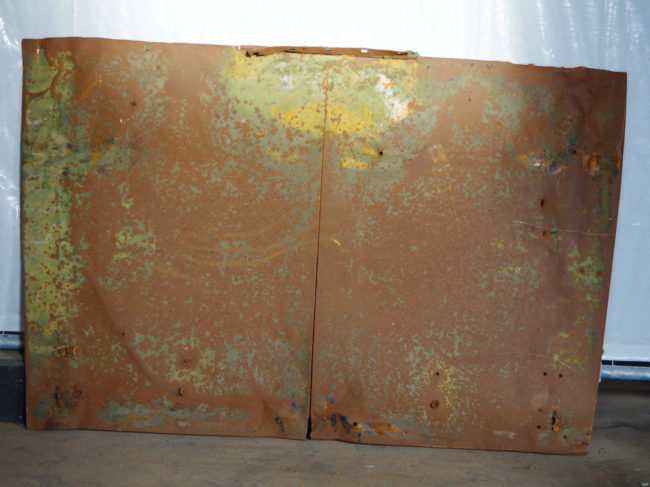




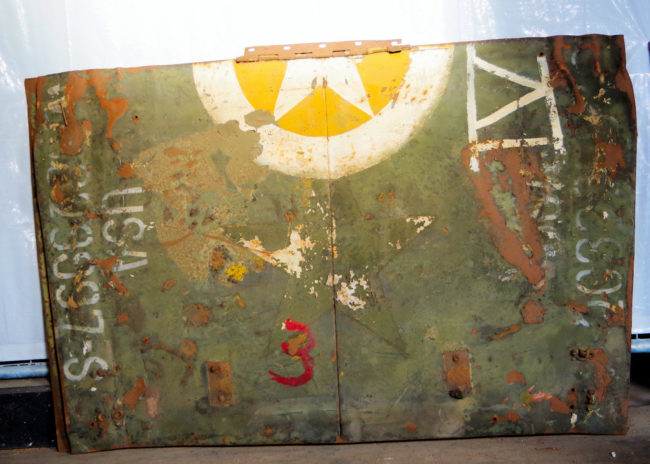
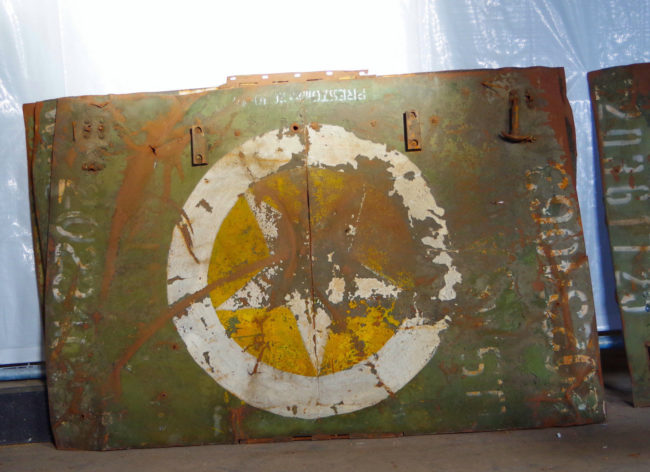
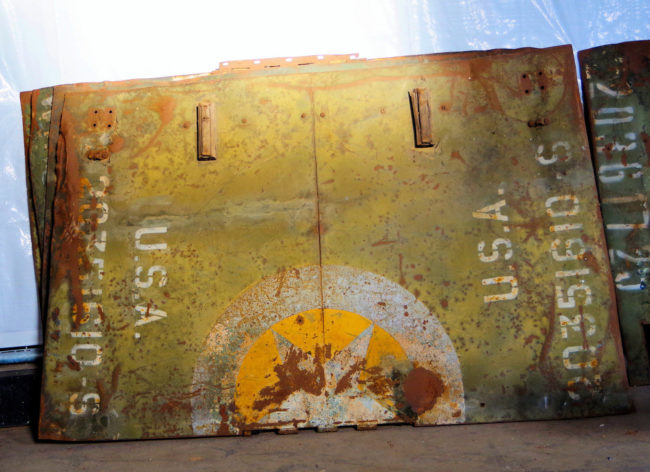
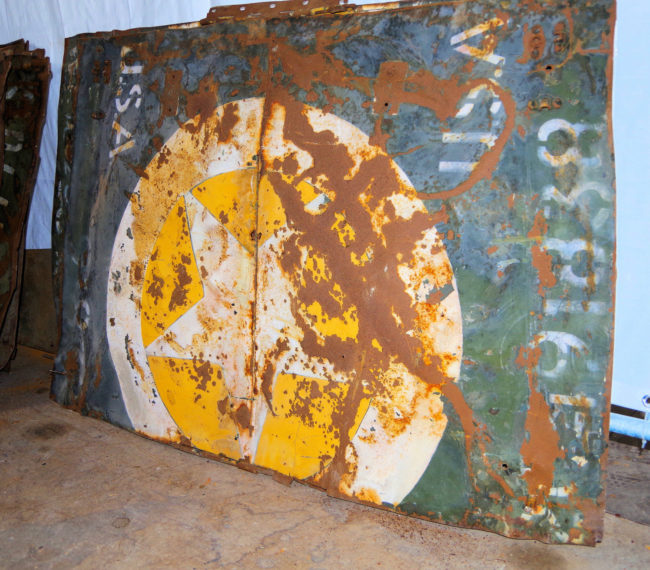
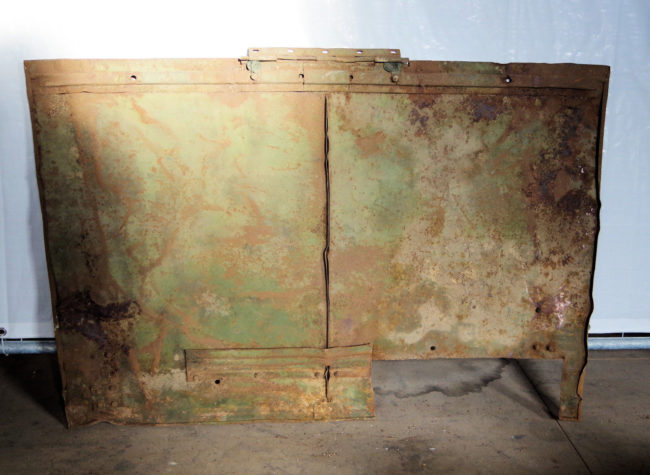
These are incredible. Would probably only be good for wall art or even museum display… but I’d love to have one.
Although an interesting story of historical significance, the value of what could be considered “SCRAP METAL” seems to be greatly inflated, at $692.00 US dollars. At that price, the hassle plus the cost of shipping would most likely make this purchase not practical for US buyers.
Then again, you never know in today’s world, we’ve all seen what is said to be a image of a saint on a potato chip sell for thousands of dollars. But, what do I know.
Spot on, Mike. While I’d love to have one, I don’t have an extra $692 laying around to throw at it… much less the added shipping. But I will not be terribly surprised if someone lays out that kind of cash: the money is in the back story, not just the “looks cool” factor.
These are the kinds of things that you just never know what they’d go for. As a piece of history, they’d interest me for a jeep museum or I might acquire one for $50 or so (assuming I could pick it up and not ship it). But, outside of that, I couldn’t personally see spending significant sums on them.
Still, these may be more culturally significant for Europeans? I just thought it was a cool bit of history.
Scrap metal? That there is an unreal conversation piece with a great story. People drop more than that on tickets for a football game or a concert. Wouldn’t be surprised if it goes well north of 1000 maybe even 2000
Its at $1200 with 3 hours left to bid.
US $2,276.45
Yo
Will be making a play to buy them all.
Will keep you all informed.
Bob in PA, Are you serious or just kidding?
Mike … he is serious.
So Bob is serious, I wasn’t sure. Dave, thanks for informing me. Sometimes, from my humble state of being, this world amazes me. Not that I begrudge anybody their wealth, how many of us have that kind of play money, I say that with great respect. My only hope is that this bulk purchase in not another money making scheme to make more money. What needs to be kept in mind are the lives that were lost during the extent of this war. To capitalize on such a shameful occurrence in history would be to dis-respect those who died.
Ended at $2,284.30. Was this Bob? That money will go a long ways on paying for that house remodel. I wish I could find that kind of money in my walls.
Like they say , ” Some people have more money than brains ” . It’ s only a squashed jeep hood with no , repeat , no historical significance .
Sure, they are flattened hoods, but they represent more than that. They demonstrate that people were so desperate for materials to rebuild their lives that they elected to use hoods. Personally, I find that historically interesting, but not all that valuable. Clearly, based on the bidding, other folks see more value in that than I (nothing wrong with that).
No historical significance? Uh, they were delivered to the army in autumn 1943, paint indicates they were intended for close proximity to combat, located in the ceiling of structure 10 miles north of Remagen. Sure open for interpretation, but they represent many things to many people. How about the historical significance of a country’s mobilization to build, ship and fight its way across Europe to bring down the Third Reich. Those hoods whether on the front line or well behind had a hand in Reich’s fall.
The evident proof of the rare mustard coloured Gas Detector paint still on the bonnet adds to the value.